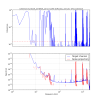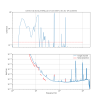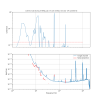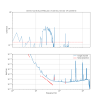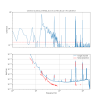Since everybody went to the holiday party tonight, I left the interferometer in low noise. After guardian was done, I punched up the input power to 25W (without reducing the DARM offset, i.e. letting the OMC current grow to 25mA), and then increased the DARM offset by another 9% (~30mA). Finally, I blindly increased the SRCLFF by 9% (punching in 1.09 in the gain), and left it there.
Looks like the machine sat there stably at 90Mpc for the whole holiday party... Merry Christmas!
The period of bad data looks to be due to a ringup of a violin mode fundamental at 516.78 Hz (ETMX mode 9). It goes up in amplitude by a factor of ~60 and becomes the largest signal on the DCPD. Once the mode becomes large enough, some nonlinearity makes a forest of lines at low frequencies, and multiples of the violin mode show up throughout the spectrum (plus an associated forest of lines). There are also lines 6.07 Hz above and below each multiple, which I think are caused by beating against 510.71 Hz. This is ETMY mode 1 according to MEDM, and it's also high but not growing during the lock. The nonlinearity becomes a problem around 5:50 UTC, when the violin mode monitor goes above 2e5 counts, see first plot. A spectrum around the line at 3*516.78 Hz is the second plot, with the lines at 6.07 Hz above and below also marked. These violin modes and their ID are given in alog 43661, though the 510 Hz line since seems to have been identified as ETMY rather than ETMX.
At around 6:00 UTC the range started to decline, it seems due to some noise in the form of a family of peaks below 40 Hz.
I ran two BruCo scans for a time before and after the change in noise.
Before: https://ldas-jobs.ligo.caltech.edu/~gabriele.vajente/bruco_lho_1228358718/
After: https://ldas-jobs.ligo.caltech.edu/~gabriele.vajente/bruco_lho_1228372218/
The most interesting thing I can see right now is that the peaks are coherent with the NULL stream.
Looking at coherences before the range worsening:
- Low frequency (below 20 Hz) ASC (DSOFT_P and CHARD_P)
- Between 15 and 40 Hz there is coherence with the centering loop DC4_P
- Coherence with MICH and SRCL is significant up to 200 Hz





